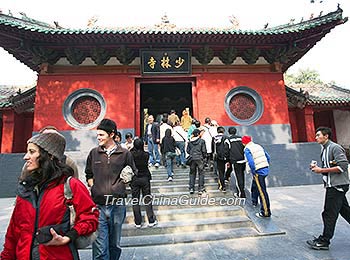Shaolin Temple, in the region of
Songshan Mountain,
Dengfeng City, Henan Province, is reputed to be 'the Number One Temple under Heaven'. Shaolin Temple history can date back to Northern Wei Dynasty (386 - 534), and it played an important role on the development of the Buddhism in China. Included on UNESCO's
World Cultural & Natural Heritage List in 2010, it is the cradle of the Chinese Zen Buddhism and the
Shaolin Martial Arts such as Shaolin Cudgel. One can see wild flowers and pines on the mountain. With birds singing and a brook spattering, a beautiful scene full of life and vitality is revealed to the visitors.
Shaolin Temple embraces many exciting attractions, such as the Hall of Heavenly Kings (Tianwangdian), the Mahavira Hall (Daxiongbaodian), the Pagoda Forest, the Dharma Cave and the Martial Art Training Center. Visitors may follow the virtual guide to visit the temple.
Shanmen Hall
First we see the Shanmen Hall. Hung on its top is a tablet reading 'Shaolin Temple'. The tablet was inscribed by the Emperor Kangxi (1622 - 1723) during the Qing Dynasty (1644 - 1911). Under the stairs of the hall crouches two stone lions made in the Ming Dynasty (1368-1644). The hall enshrines the Maitreya Buddha. Two sides of the corridor behind the hall's gate are paved with inscriptions on stone steles made during several different dynasties.
Hall of Heavenly Kings
Next we arrive at the Hall of Heavenly Kings. The gate of the hall is guarded by two figures depicting Vajra (Buddhist warrior attendants). Inside the hall are figures of the Four Heavenly Kings who are responsible for inspecting peoples' behavior, helping the troubled, and blessing the people.
Mahavira Hall
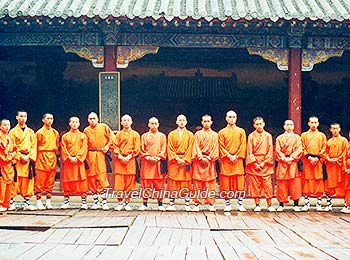 |
| Followers of Shaolin Martial Art |
Then we come to the Mahavira Hall. The complex center is right before your eyes. Both important celebrations and regular prayers are held here. 18 Buddhist Arhats stand along the eastern and the southern walls of the hall. Buddhas of the Middle, East and West are enshrined in this hall, respectively Sakyamuni Buddha, Pharmacist Buddha and Amitabha Buddha. Figures of Kingnaro (the founder of Shaolin Cudgel) and Dharma (the founder of Chinese Zen Buddhism) stand beside those three Buddhas, a placement which is very different from other Mahavira Halls. At the feet of the pillars in this Mahavira Hall are stone lions that are more than one meter (about 3.33 feet) high. On the ground there are about 50 small pits, 20 centimeters (about 7.87 inches) deep. It is said that they are the footprints left by monks when they practiced Shaolin Martial Arts.
Pagoda Forest
Unexpectedly, we come to the Pagoda Forest, a graveyard for Buddhist dignitaries through the ages. On average, the pagodas are less than 15 meters (about 49 feet) high. The layer and the shape of a pagoda depend on many factors, such as one's Buddhist status, attainment and prestige during his lifetime. The Pagoda Forest here is the largest of China's pagoda complexes.
Ancestor's Monastery & the Second Ancestor's Monastery
Outside the Shaolin Temple we continue walking to the northwest, and then we will take a look at two monasteries, named the Ancestor's Monastery and the Second Ancestor's Monastery. The first monastery is built by a Dharma's disciple to commemorate Dharma's
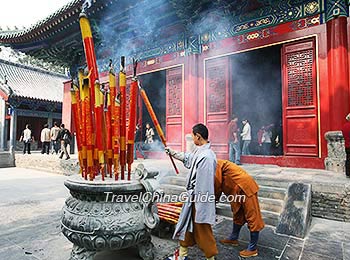 |
| Burn incense and pray |
nine years of meditation in a cave. It has a big hall supported by 16 stone pillars on whose shafts are exquisitely carved warriors, dancing dragons and phoenixes. The second monastery is a nursing home of the second ancestor Huike who cut his left arm in order to show his sincerity to study Buddhism from Dharma. In front of the monastery are four springs created by Dharma to help Huike to fetch water easily. They are called 'Spring Zhuoxi' and each has its own distinctive flavor.
Dharma Cave
The cave we see next is the Dharma Cave. In this cave Dharma patiently faced the wall and meditated for 9 years. Finally, he reached the immortal spiritual state and created the Buddhist Zen. The cave is seven meters deep (about 23 feet) and three meters high (about 9.8 feet). Many stone inscriptions are carved on both its sides. There is a Meditating Stone in the cave. It is said Dharma's shadow was reflected upon the stone and embedded on it because of the long time of his meditation facing the wall. Unfortunately the stone was ruined during the war.
Buddhist Living Quarters
After passing the Dharma Cave, we come to the Buddhist Living Quarters for transient monks. It is on the south bank of the Shaoxi River opposite the temple. First built in 1512 of the Ming Dynasty, it was repaired in the Qing Dynasty. The quarters are noted for the simple and distinctive design. It collapsed in 1958 and then repaired in 1993.
Wushu (Martial Arts) Training Center
The Shaolin Temple Wushu (Martial Arts) Training Center comes last. Its perfect scenery makes it an ideal place for practicing the Chinese
Shaolin Kung Fu. Shaolin monks have been practicing Kung Fu for over 1,500 years. The system was invented by Dharma who taught the monks basic methods to improve their health and defend themselves. The Martial art performance shows the true Chinese Shaolin Temple Kung Fu. For example, Tong Zi Gong, performed by teenagers, is a kind of martial art to train one's flexibility and strength.
In a word, Shaolin Temple is worthy of a visit. It will give you a better understanding of
Chinese Buddhism and the Chinese martial arts.
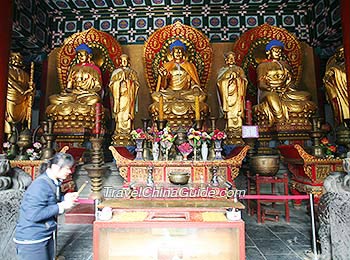 | | Buddha statues | | 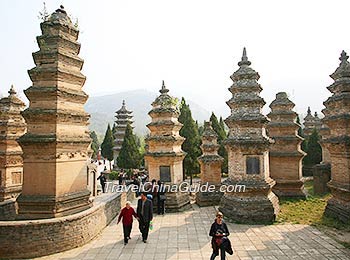 | | The pagoda forest | |
Ticket & Opening Hours
| Entrance Fee | CNY80 |
| Opening Hours | 7:00 - 17:00; ticket selling starts 30mins earlier. |
| Recommended Time for a Visit | 2-3h |
How to get to Shaolin Temple
From Dengfeng City: 30min by taxi
Dengfeng Bus Line 1 can take passengers to Xishili Bus Station, the nearest station to Shaolin temple. After getting off, passengers need to walk northward for 6 kilometers (3.72 miles) to the gate of the scenic area. Taking a taxi is more comfortable, taking only half an hour and about CNY 40-60.
From Zhengzhou

Direct Bus:
Take a bus from Zhengzhou Central Bus Station to Shaolinsi (Shaolin Temple) directly. The bus departs at 7:30, 8:00, 08:30 and 9:40. The bus fare is CNY 30 and the duration is 2h.

Bullet Train + Bus
Or passengers can take a high speed train at Zhengzhou or Zhengzhou East Railway Station to
Luoyang Longmen Railway Station, taking CNY46.5-65.5 with a duration of 40 minutes. On the west of Longmen Rail Station, there is Longmen Transportation Center operating buses to Shanlin Temple departing at 09:00, 10:30, 14:30 and 16:30. The ticket fare is CNY 35 and the duration is about 1-1.5h.
Longmen Transportation Center can be easily reached by Luoyang metro line 2

See more
Zhengzhou - Luoyang Train From Luoyang: Direct Bus
Take a direct bus from Luoyang Longmen Transportation Center to Shaolin Temple, taking CNY 35 with a duration of 1-1.5h. The departure is at 09:00, 10:30, 14:30 and 16:30.
Luoyang Bus Station near Luoyang Railway Station also operates buses to Shaolin Temple departing at 06:50, 07:45, 08:05, 08:50 09:50, 10:20, 11:30, 12:40, 13:40, 14:40, 16:30, 17:20, 17:50. The ticket costs CNY 25 and journey takes about 2 hours.

Shalin Temple is not the final destination of the buses, just one stop.
From Xi'an: Bullet Train + Bus
Take a high speed train at
Xi'an North Railway Station to Luoyang Longmen Railway Station at a cost of CNY 174.5 and with a duration of about 1.5h. Then take a direct bus to Shaoliin Temple at Longmen Transportation Center on the west of Longmen Rail Station.
What to see nearby Shaolin Temple
About 7 kilometers away from (4 miles) southeast of Shaolin Temple, there offered a feast to the eyes and ears -
Shaolin Zen Music Ritual, which is the largest-scale outdoor performance in mountains in the world. With various factors contained, a magnificent performance is made to show the Zen Buddhism concepts, including Zen Buddhism music, martial arts and dance of local shepherdesses. Usually, the performing time is 20:00 - 21:15 from March to November.
- Last updated on Oct. 14, 2024 by Gabby Li -


